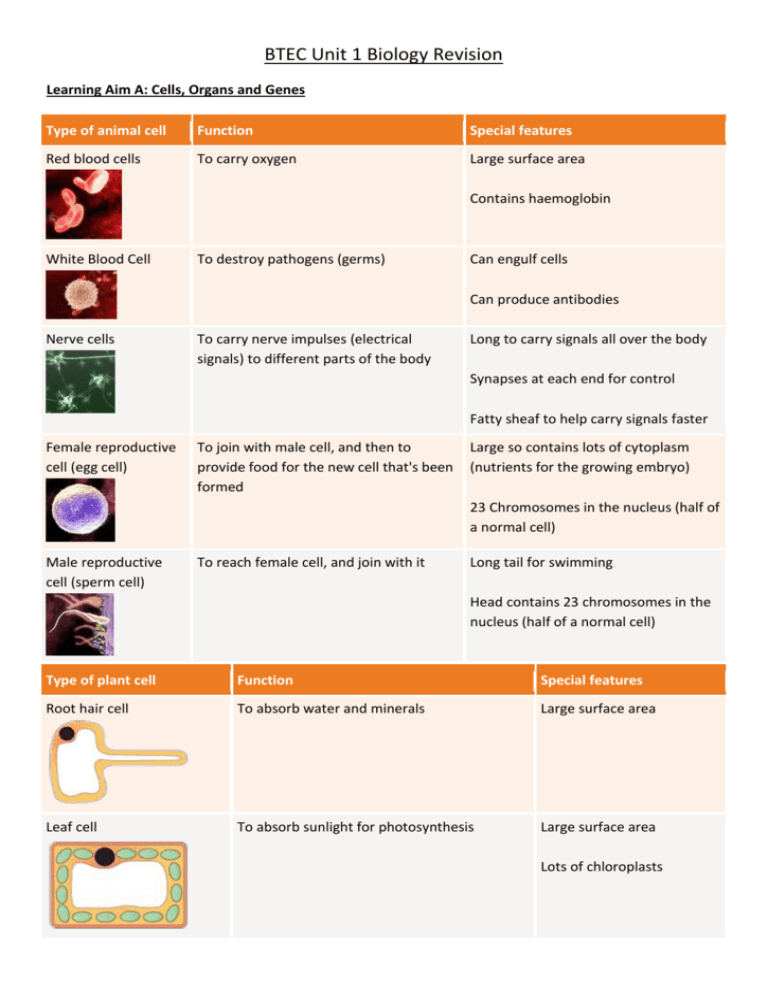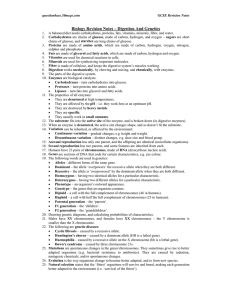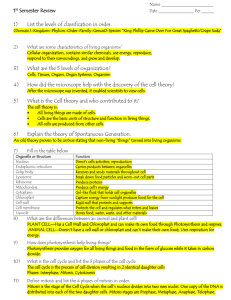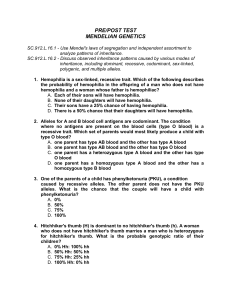BTEC Unit 1 Biology Revision
advertisement

BTEC Unit 1 Biology Revision Learning Aim A: Cells, Organs and Genes Type of animal cell Function Red blood cells To carry oxygen Special features Large surface area White Blood Cell To destroy pathogens (germs) Contains haemoglobin Can engulf cells Can produce antibodies Nerve cells To carry nerve impulses (electrical signals) to different parts of the body Long to carry signals all over the body Synapses at each end for control Female reproductive cell (egg cell) To join with male cell, and then to provide food for the new cell that's been formed Fatty sheaf to help carry signals faster Large so contains lots of cytoplasm (nutrients for the growing embryo) 23 Chromosomes in the nucleus (half of a normal cell) Male reproductive cell (sperm cell) To reach female cell, and join with it Long tail for swimming Head contains 23 chromosomes in the nucleus (half of a normal cell) Type of plant cell Function Special features Root hair cell To absorb water and minerals Large surface area Leaf cell To absorb sunlight for photosynthesis Large surface area Lots of chloroplasts Part Function Found in Cell membrane Controls what substances can get into and out of the cell. Plant and animal cells Cytoplasm Where chemical reactions happen. Plant and animal cells Nucleus Controls what happens inside the cell. Contains genetic information. Plant and animal cells Mitochondria Where respiration (to generate energy) happens Plant and animal cells Chloroplast Where photosynthesis happens – chloroplasts contain a green substance called chlorophyll. Plant cells only Vacuole Contains a liquid called cell sap, provides support. Plant cells only Cell wall Made of a tough substance called cellulose, which supports the cell. Plant cells only Parts of a Plant and Transpiration A) Roots: Roots anchor the plant in the soil and take in water and minerals B) Stem: Xylem cells in the stem carry water and minerals up the plant to the leaves. Phloem cells in the stem carry glucose. C) Leaf: Transpiration = water evaporates from holes in the leaf (stomata), this pulls water up through the plant. Photosynthesis also happens in the leaves. DNA and Inheritance DNA is made of two strands of bases in a double helix Adenine pairs with Thymine A-T Cytosine pairs with Guanine C-G Sections of DNA are called genes and these are the instructions for characteristics eg: eye colour Lots of DNA is packed into a chromosome Chromosomes are found in the cell nucleus 46 Chromosomes in a normal human cell Different forms of the same gene are called alleles eg: the gene for eye colour has an allele for blue eye colour and an allele for brown eye colour. One allele comes from your mum and one from your dad. Alleles are dominant or recessive, meaning: The dominant allele always produces the characteristic even if you have a recessive allele as well The recessive allele characteristic is only shown if you have two recessive alleles The disease sickle cell anaemia is caused by a faulty recessive allele You only get the disease if you inherit two copies of the recessive allele If you have one healthy dominant copy of the allele and one faulty recessive allele then you are a carrier of the disease. A mutation is a change in the DNA base sequence This can change the characteristics of an organism A mutation can cause cancer Learning Aim B: Nerves and Hormones in Homeostasis Homeostasis is the maintenance of a constant internal environment eg: keeping your temperature the same. A synapse is a gap between 2 nerve cells An electrical impulse arrives at the first nerve (1+2) A chemical (neurotransmitter) crosses the gap (3) A new electrical impulse is started in the next nerve cell (4) Central Nervous System (CNS) = Brain and Spinal cord Peripheral Nervous System (PNS) = sensory and motor nerves Nervous system responses can be voluntary or involuntary Voluntary = under your control eg: putting your hand up Involuntary = a fast reflex action to protect you from harm (see below) Nerves versus Hormones Speed of Communication Method of Transmission Duration of Response Nerves Fast Electricity Short Hormones Slow In blood Long Controlling blood glucose (sugar) levels glucose level effect on pancreas effect on liver effect on glucose level too high insulin secreted into the blood liver converts glucose into glycogen goes down too low insulin not secreted into the blood liver does not convert glucose into glycogen goes up Controlling body Temperature









